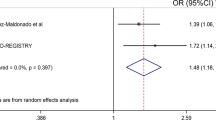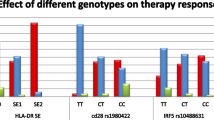Abstract
Rheumatoid arthritis (RA) patients can be stratified into two subgroups defined by the presence or absence of antibodies against citrullinated circular peptides (anti-CCP) with most of the genetic association found in anti-CCP positive RA. Here we addressed the role of VAV1, previously associated to multiple sclerosis (MS), in the pathogenesis of RA in experimental models and in a genetic association study. Experimental arthritis triggered by pristane or collagen type II was induced in DA rats and in the DA.BN-R25 congenic line that carries a polymorphism in Vav1. Difference in arthritis severity was observed only after immunization with pristane. In a case–control study, 34 SNPs from VAV1 locus were analyzed by Immunochip genotyping in 11475 RA patients (7573 anti-CCP positive and 3902 negative) and 15,870 controls in six cohorts of European Caucasians. A combination of the previous MS-associated haplotype and two additional SNPs was associated with anti-CCP negative RA (alleles G-G-A-A of rs682626-rs2546133-rs2617822-rs12979659, OR=1.13, P=1.27 × 10−5). The same markers also contributed to activity of RA at baseline with the strongest association in the anti-CCP negative group for the rs682626-rs12979659 G-A haplotype (β=−0.283, P=0.0048). Our study suggests a role for VAV1 and T-cell signaling in the pathology of anti-CCP-negative RA.
This is a preview of subscription content, access via your institution
Access options
Subscribe to this journal
Receive 6 digital issues and online access to articles
$119.00 per year
only $19.83 per issue
Buy this article
- Purchase on Springer Link
- Instant access to full article PDF
Prices may be subject to local taxes which are calculated during checkout




Similar content being viewed by others
References
Ruyssen-Witrand A, Constantin A, Cambon-Thomsen A, Thomsen M . New insights into the genetics of immune responses in rheumatoid arthritis. Tissue Antigens 2012; 80: 105–118.
Padyukov L, Seielstad M, Ong RT, Ding B, Ronnelid J, Seddighzadeh M et al. A genome-wide association study suggests contrasting associations in ACPA-positive versus ACPA-negative rheumatoid arthritis. Ann Rheum Dis 2011; 70: 259–265.
Klareskog L, Stolt P, Lundberg K, Kallberg H, Bengtsson C, Grunewald J et al. A new model for an etiology of rheumatoid arthritis: smoking may trigger HLA-DR (shared epitope)-restricted immune reactions to autoantigens modified by citrullination. Arthritis Rheum 2006; 54: 38–46.
Stahl EA, Raychaudhuri S, Remmers EF, Xie G, Eyre S, Thomson BP et al. Genome-wide association study meta-analysis identifies seven new rheumatoid arthritis risk loci. Nat Genet 2010; 42: 508–514.
Okada Y, Wu D, Trynka G, Raj T, Terao C, Ikari K et al. Genetics of rheumatoid arthritis contributes to biology and drug discovery. Nature 2014; 506: 376–381.
Julia A, Marsal S . The genetic architecture of rheumatoid arthritis: from susceptibility to clinical subphenotype associations. Curr Top Med Chem 2013; 13: 720–731.
Han B, Diogo D, Eyre S, Kallberg H, Zhernakova A, Bowes J et al. Fine mapping seronegative and seropositive rheumatoid arthritis to shared and distinct HLA alleles by adjusting for the effects of heterogeneity. Am J Hum Genet 2014; 94: 522–532.
Eyre S, Bowes J, Diogo D, Lee A, Barton A, Martin P et al. High-density genetic mapping identifies new susceptibility loci for rheumatoid arthritis. Nat Genet 2012; 44: 1336–1340.
Viatte S, Massey J, Bowes J, Duffus K, arc, Eyre S et al. Replication of genetic loci outside the HLA conferring susceptibility to anti-CCP negative rheumatoid arthritis. Arthritis Rheumatol 2016; 68: 1603–1613.
Bossini-Castillo L, de Kovel C, Kallberg H, van 't Slot R, Italiaander A, Coenen M et al. A genome-wide association study of rheumatoid arthritis without antibodies against citrullinated peptides. Ann Rheum Dis 2015; 74: e15.
International Multiple Sclerosis Genetics C International Multiple Sclerosis Genetics C Beecham AH, International Multiple Sclerosis Genetics C Patsopoulos NA, International Multiple Sclerosis Genetics C Xifara DK, International Multiple Sclerosis Genetics C Davis MF, International Multiple Sclerosis Genetics C Kemppinen A et al. Analysis of immune-related loci identifies 48 new susceptibility variants for multiple sclerosis. Nat Genet 2013; 45: 1353–1360.
Jagodic M, Colacios C, Nohra R, Dejean AS, Beyeen AD, Khademi M et al. A role for VAV1 in experimental autoimmune encephalomyelitis and multiple sclerosis. Sci Transl Med 2009; 1: 10ra21.
McInnes IB, Schett G . Cytokines in the pathogenesis of rheumatoid arthritis. Nat Rev Immunol 2007; 7: 429–442.
Griffiths MM, Wang J, Joe B, Dracheva S, Kawahito Y, Shepard JS et al. Identification of four new quantitative trait loci regulating arthritis severity and one new quantitative trait locus regulating autoantibody production in rats with collagen-induced arthritis. Arthritis Rheum 2000; 43: 1278–1289.
Furuya T, Salstrom JL, McCall-Vining S, Cannon GW, Joe B, Remmers EF et al. Genetic dissection of a rat model for rheumatoid arthritis: significant gender influences on autosomal modifier loci. Hum Mol Genet 2000; 9: 2241–2250.
Mas M, Cavailles P, Colacios C, Subra JF, Lagrange D, Calise M et al. Studies of congenic lines in the Brown Norway rat model of Th2-mediated immunopathological disorders show that the aurothiopropanol sulfonate-induced immunological disorder (Aiid3) locus on chromosome 9 plays a major role compared to Aiid2 on chromosome 10. J Immunol 2004; 172: 6354–6361.
Mas M, Subra JF, Lagrange D, Pilipenko-Appolinaire S, Kermarrec N, Gauguier D et al. Rat chromosome 9 bears a major susceptibility locus for IgE response. Eur J Immunol 2000; 30: 1698–1705.
Fujikawa K, Miletic AV, Alt FW, Faccio R, Brown T, Hoog J et al. Vav1/2/3-null mice define an essential role for Vav family proteins in lymphocyte development and activation but a differential requirement in MAPK signaling in T and B cells. J Exp Med 2003; 198: 1595–1608.
Wernhoff P, Olofsson P, Holmdahl R . The genetic control of rheumatoid factor production in a rat model of rheumatoid arthritis. Arthritis Rheum 2003; 48: 3584–3596.
Lazer G, Katzav S . Guanine nucleotide exchange factors for RhoGTPases: good therapeutic targets for cancer therapy? Cell Signal 2011; 23: 969–979.
Jux B, Staratschek-Jox A, Penninger JM, Schultze JL, Kolanus W . Vav1 regulates MHCII expression in murine resting and activated B cells. Int Immunol 2013; 25: 307–317.
Turner M, Mee PJ, Walters AE, Quinn ME, Mellor AL, Zamoyska R et al. A requirement for the Rho-family GTP exchange factor Vav in positive and negative selection of thymocytes. Immunity 1997; 7: 451–460.
Tedford K, Nitschke L, Girkontaite I, Charlesworth A, Chan G, Sakk V et al. Compensation between Vav-1 and Vav-2 in B cell development and antigen receptor signaling. Nat Immunol 2001; 2: 548–555.
Holmberg J, Tuncel J, Yamada H, Lu S, Olofsson P, Holmdahl R . Pristane, a non-antigenic adjuvant, induces MHC class II-restricted, arthritogenic T cells in the rat. J Immunol 2006; 176: 1172–1179.
Goldschmidt TJ, Holmdahl R . Anti-T cell receptor antibody treatment of rats with established autologous collagen-induced arthritis: suppression of arthritis without reduction of anti-type II collagen autoantibody levels. Eur J Immunol 1991; 21: 1327–1330.
Haag S, Schneider N, Mason DE, Tuncel J, Andersson IE, Peters EC et al. Identification of new citrulline-specific autoantibodies, which bind to human arthritic cartilage, by mass spectrometric analysis of citrullinated type II collagen. Arthritis Rheumatol 2014; 66: 1440–1449.
Hoffmann MH, Tuncel J, Skriner K, Tohidast-Akrad M, Turk B, Pinol-Roma S et al. The rheumatoid arthritis-associated autoantigen hnRNP-A2 (RA33) is a major stimulator of autoimmunity in rats with pristane-induced arthritis. J Immunol 2007; 179: 7568–7576.
Stoop JN, Fischer A, Hayer S, Hegen M, Huizinga TW, Steiner G et al. Anticarbamylated protein antibodies can be detected in animal models of arthritis that require active involvement of the adaptive immune system. Ann Rheum Dis 2015; 74: 949–950.
Nandakumar KS, Backlund J, Vestberg M, Holmdahl R . Collagen type II (CII)-specific antibodies induce arthritis in the absence of T or B cells but the arthritis progression is enhanced by CII-reactive T cells. Arthritis Res Ther 2004; 6: R544–R550.
Forster M, Raposo B, Ekman D, Klaczkowska D, Popovic M, Nandakumar KS et al. Genetic control of antibody production during collagen-induced arthritis development in heterogeneous stock mice. Arthritis Rheum 2012; 64: 3594–3603.
Holmdahl R, Lorentzen JC, Lu S, Olofsson P, Wester L, Holmberg J et al. Arthritis induced in rats with nonimmunogenic adjuvants as models for rheumatoid arthritis. Immunol Rev 2001; 184: 184–202.
van Oosterhout M, Bajema I, Levarht EW, Toes RE, Huizinga TW, van Laar JM . Differences in synovial tissue infiltrates between anti-cyclic citrullinated peptide-positive rheumatoid arthritis and anti-cyclic citrullinated peptide-negative rheumatoid arthritis. Arthritis Rheum 2008; 58: 53–60.
Humby F, Bombardieri M, Manzo A, Kelly S, Blades MC, Kirkham B et al. Ectopic lymphoid structures support ongoing production of class-switched autoantibodies in rheumatoid synovium. PLoS Med 2009; 6: e1.
Gottenberg JE, Miceli-Richard C, Ducot B, Goupille P, Combe B, Mariette X . Markers of B-lymphocyte activation are elevated in patients with early rheumatoid arthritis and correlated with disease activity in the ESPOIR cohort. Arthritis Res Ther 2009; 11: R114.
Gottenberg JE, Dayer JM, Lukas C, Ducot B, Chiocchia G, Cantagrel A et al. Serum IL-6 and IL-21 are associated with markers of B cell activation and structural progression in early rheumatoid arthritis: results from the ESPOIR cohort. Ann Rheum Dis 2012; 71: 1243–1248.
Isaacs JD, Cohen SB, Emery P, Tak PP, Wang J, Lei G et al. Effect of baseline rheumatoid factor and anticitrullinated peptide antibody serotype on rituximab clinical response: a meta-analysis. Ann Rheum Dis 2013; 72: 329–336.
Lu S, Carlsen S, Hansson AS, Holmdahl R . Immunization of rats with homologous type XI collagen leads to chronic and relapsing arthritis with different genetics and joint pathology than arthritis induced with homologous type II collagen. J Autoimmun 2002; 18: 199–211.
Arnett FC, Edworthy SM, Bloch DA, McShane DJ, Fries JF, Cooper NS et al. The American Rheumatism Association 1987 revised criteria for the classification of rheumatoid arthritis. Arthritis Rheum 1988; 31: 315–324.
Kallberg H, Ding B, Padyukov L, Bengtsson C, Ronnelid J, Klareskog L et al. Smoking is a major preventable risk factor for rheumatoid arthritis: estimations of risks after various exposures to cigarette smoke. Ann Rheum Dis 2011; 70: 508–511.
Purcell S, Neale B, Todd-Brown K, Thomas L, Ferreira MA, Bender D et al. PLINK: a tool set for whole-genome association and population-based linkage analyses. Am J Hum Genet 2007; 81: 559–575.
Barrett JC, Fry B, Maller J, Daly MJ . Haploview: analysis and visualization of LD and haplotype maps. Bioinformatics 2005; 21: 263–265.
Acknowledgements
This work was supported by grants from the Knut and Alice Wallenberg Foundation, the Borje Dahlin Foundation, the Swedish Association against Rheumatism (Svenska Reumatikerförbundet), the Swedish Medical Research Council (Vetenskapsrådet), the Swedish Innovation Agency (Combine - Vinnova), the Swedish Foundation for Strategic Research (SSF), the European Community’s Seventh Framework Program (FP7/2007-2013) under the grant agreement N° HEALTH-F4-2010-241504 (EURATRANS), as well as the IMI project BeTheCURE.
Author information
Authors and Affiliations
Consortia
Corresponding author
Ethics declarations
Competing interests
The authors declare no conflict of interest.
Rights and permissions
About this article
Cite this article
Guerreiro-Cacais, A., Norin, U., Gyllenberg, A. et al. VAV1 regulates experimental autoimmune arthritis and is associated with anti-CCP negative rheumatoid arthritis. Genes Immun 18, 48–56 (2017). https://doi.org/10.1038/gene.2016.49
Received:
Revised:
Accepted:
Published:
Issue Date:
DOI: https://doi.org/10.1038/gene.2016.49
This article is cited by
-
Association analysis of juvenile idiopathic arthritis genetic susceptibility factors in Estonian patients
Clinical Rheumatology (2021)
-
Rat models of human diseases and related phenotypes: a systematic inventory of the causative genes
Journal of Biomedical Science (2020)
-
Cell death pathologies: targeting death pathways and the immune system for cancer therapy
Genes & Immunity (2019)
-
How to manage rheumatoid arthritis according to classic biomarkers and polymorphisms?
Frontiers in Biology (2017)



